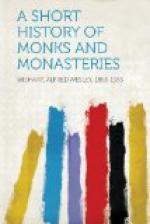After 450 A.D., monasticism suffered an eclipse for over half a century. It seemed as if the Western institution was destined to end in that imbecility and failure which overtook the Eastern system. But there came a man who infused new life into the monastic body. He systematized its scattered principles and concentrated the energies of the wandering and unorganized monks.
Our next visit will be to the mountain home of this renowned character, fifty miles to the west of Rome. “A single monk,” says Montalembert, “is about to form there a center of spiritual virtue, and to light it up with a splendor destined to shine over regenerated Europe for ten centuries to come.”
III
THE BENEDICTINES
Saint Benedict, the founder of the famous monastic order that bears his name, was born at Nursia, about 480 A.D. His parents, who were wealthy, intended to give him a liberal education; but their plans were defeated, for at fifteen years of age Benedict renounced his family and fortune, and fled from his school life in Rome. The vice of the city shocked and disgusted him. He would rather be ignorant and holy, than educated and wicked. On his way into the mountains, he met a monk named Romanus,—the spot is marked by the chapel of Santa Crocella,—who gave him a haircloth shirt and a monastic dress of skins. Continuing his journey with Romanus, the youthful ascetic discovered a sunless cave in the desert of Subiaco, about forty miles from Rome. Into this cell he climbed, and in it he lived three years. It was so inaccessible that Romanus had to lower his food to him by a rope, to which was attached a bell to call him from his devotions. Once the Devil threw a stone at the rope and broke it.
But Benedict’s bodily escape from the wickedness of Rome did not secure his spiritual freedom. “There was a certain lady of thin, airy shape, who was very active in this solemnity; her name was Fancy.” Time and again, he revisited his old haunts, borne on the wings of his imagination. The face of a beautiful young girl of previous acquaintance constantly appeared before him. He was about to yield to the temptation and to return, when, summoning all his strength, he made one mighty effort to dispel the illusion forever. Divesting himself of his clothes, he rolled his naked body among the thorn-bushes near his cave. It was drastic treatment, but it seems to have rid his mind effectually of disturbing fancies. This singular self-punishment was used by Godric, the Welsh saint, in the twelfth century. “Failing to subdue his rebellious flesh by this method, he buried a cask in the earthen floor of his cell, filled it with water and fitted it with a cover, and in this receptacle he shut himself up whenever he felt the titillations of desire. In this manner, varied by occasionally passing the night up to his chin in a river, of which he had broken the ice, he finally succeeded in mastering his fiery nature.”




